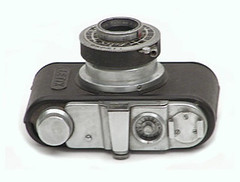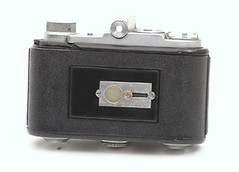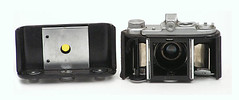Letix
The Letix is a Japanese camera taking 4×4cm on 127 film and partly made of bakelite. It was produced from 1940 by Asahi Kōgaku Kōgyō, a dependent company of Riken Kōgaku Kōgyō (today Ricoh), and was a remote evolution of the Olympic cameras.[1] At about the same time, Riken itself was also making the Roico, an all-metal 4×4 camera.
Contents
Description of the body
The Letix has a bakelite body, as the Olympic, but the lens and shutter assembly is mounted on a metal telescopic tube. The name of the camera is moulded in the front of the body. The name appears as LETIX in capital letters on many examples,[2] and as Letix in cursive style in advertising pictures.[3] At least two examples are known with the body marked Retix.[4] An explanation for that funny mistake is that the Japanese phonology does not distinguish between the "l" and "r" letters.

|

|

| |
| Letix with Retix marking, Ukas Anastigmat 50mm f/4.5 lens no.A-11258, AKK shutter. Pictures by eBayer comprar83. (Image rights) | |
The Letix is covered by a top housing except the space around the advance knob, at the left end of the top plate. The advance knob itself is quite thick, and the camera is equipped with auto-stop film advance. The tubular optical finder is a distinct part, centred above the top housing, and there is an accessory shoe on the right end. Between the shoe and the finder is an exposure counter made of a fully exposed disc engraved from 1 to 12. This device was necessary because at the time, the film paperback was not marked for 4×4cm pictures. Between the finder and the advance knob there is a button that perhaps unlocks the auto-stop advance device. The back is removable together with the bottom plate, and has a single red window to set the first exposure, protected by a horizontally sliding cover. The back is locked by a knob surrounding the tripod mount, at the centre of the bottom plate.
 
|
 
|
| Letix with LETIX marking, Ukas Anastigmat 50mm f/4.5 lens, AKK shutter. Pictures by eBayer neatphoto. (Image rights) |
Relation with the Kraft
The early version of the Kraft made by Echt from about 1940 is very similar to the Letix, but its main body is made of metal instead of bakelite. The two cameras have the same viewfinder, exposure counter, advance knob, accessory shoe and telescopic tube, and their top housing is only slightly different. Those parts were probably supplied by Echt to Asahi Kōgaku Kōgyō, which was probably specialized in bakelite cameras — the reverse seems less likely.
Commercial life
The earliest known advertisement for the Letix is in Asahi Camera October 1940.[5] It mentions the manufacturer Asahi Kōgaku Kōgyō and the distributor Kaneki Shōten, and offers the camera with a front-cell focusing Ukas Anastigmat 50mm f/4.5 (a lens equipping many models of the Olympic) and a shutter giving 25, 50, 100, 150, B, T speeds. Other advertisements in the same magazine dated November 1940 (by Asahi Kōgaku Kōgyō) and August 1941 (by Kawara Shashinki-ten, another distributor) list the Letix with the same lens and shutter combination for ¥55.[6]
The camera appears in the official list of set prices compiled in October 1940 and published in January 1941, under the names "Letix I" (¥60) and "Letix II" (¥95), with no further details.[7] The last known mention of the camera is in a column of the February 1942 issue of Asahi Camera.
Surviving examples
Examples of the Letix have been observed with the Ukas lens and 25–150 speeds.[8] The shutter plate has decorative patterns, is marked Letix at the top, has an AKK logo on the right (surely for Asahi Kōgaku Kōgyō) and the aperture scale at the bottom. The speeds are written on the rim in the following order: T, B, 150, 100, 50, 25. The shutter is everset, and it is probably the same as mounted on the Olympic cameras.
Another version of the Letix has been observed, perhaps corresponding to the Letix II.[9] It has a 5cm f/4.5 lens reported as a Helios Anastigmat, probably a three-element lens made by Tōkyō Shashin Kōgaku.[10] The shutter is an everset Perfect (5–250, B, T) by Neumann & Heilemann, in #00 size with the early shutter plate design (see Perfect). (A similar lens and shutter combination is found on the Seica.) The known pictures perhaps correspond to a single surviving example; it is also distinguished by the reduced frame around the viewfinder window.
Notes
- ↑ Attribution to Asahi Kōgaku Kōgyō: advertisement in Asahi Camera October 1940 reproduced in Kokusan kamera no rekishi, p.104. Dates: Kokusan kamera no rekishi, p.343.
- ↑ Examples pictured in this very article, in this page and this page at Asacame and in "Senzen no rikō kamera — hoi", pp.21–2 of Kurashikku Kamera Senka no.14 (a small picture is reproduced in this page of the Ricoh official website).
- ↑ Advertisements in Asahi Camera October 1940 and August 1941 reproduced in Kokusan kamera no rekishi, pp.61 and 104.
- ↑ Example pictured in McKeown, p.85, and example observed in an online auction.
- ↑ Advertisement reproduced in Kokusan kamera no rekishi, p.104. This is the earliest advertisement listed in Kokusan kamera no rekishi, p.343.
- ↑ November 1940: advertisement visible in this page of Xylocopal's photolog (archived). August 1941: advertisement reproduced in Kokusan kamera no rekishi, p.61.
- ↑ "Kokusan shashinki no kōtei kakaku", type 1, sections 5 and 9.
- ↑ Examples pictured in this article, in McKeown, p.85, in Sugiyama, item 3031, in this page of the AJCC and in this page and this page at Asacame.
- ↑ Example pictured in Sugiyama, item 3032, and in "Senzen no rikō kamera — hoi", pp.21–2 of Kurashikku Kamera Senka no.14 (a small picture is reproduced in this page of the Ricoh official website).
- ↑ Made by Tōkyō Shashin Kōgaku: "Kokusan shashinki no genjōchōsa" ("Inquiry into Japanese cameras"), lens item Jc12 for an Helios 50/4.5 lens mounted on the Baby Germa.
Bibliography
- Asahi Camera (アサヒカメラ) editorial staff. Shōwa 10–40nen kōkoku ni miru kokusan kamera no rekishi (昭和10–40年広告にみる国産カメラの歴史, Japanese camera history as seen in advertisements, 1935–1965). Tokyo: Asahi Shinbunsha, 1994. ISBN 4-02-330312-7. Item 319. (See also the advertisement for item 35.)
- "Kokusan shashinki no kōtei kakaku" (国産写真機の公定価格, Set prices of the Japanese cameras), listing Japanese camera production as of October 25, 1940 and setting the retail prices from December 10, 1940. Published in Asahi Camera January 1941 and reproduced in Shōwa 10—40nen kōkoku ni miru kokusan kamera no rekishi (昭和10〜40年広告にみる国産カメラの歴史, Japanese camera history as seen in advertisements, 1935—1965). Tokyo: Asahi Shinbunsha, 1994. ISBN 4-02-330312-7. Pp.108—9. Type 1, sections 5 and 9.
- McKeown, James M. and Joan C. McKeown's Price Guide to Antique and Classic Cameras, 12th Edition, 2005-2006. USA, Centennial Photo Service, 2004. ISBN 0-931838-40-1 (hardcover). ISBN 0-931838-41-X (softcover). P.85.
- "Senzen no rikō kamera — hoi" (戦前のリコーカメラ・補遺, Prewar Ricoh cameras — appendix). Kamera Rebyū: Kurashikku Kamera Senka (カメラレビュー クラシックカメラ専科) / Camera Review: All about Historical Cameras no.14, October 1989. No ISBN number. Rikō kamera no subete (リコーカメラのすべて, special issue on Ricoh). Pp.21–2.
- Sugiyama, Kōichi (杉山浩一); Naoi, Hiroaki (直井浩明); Bullock, John R. The Collector's Guide to Japanese Cameras. 国産カメラ図鑑 (Kokusan kamera zukan). Tokyo: Asahi Sonorama, 1985. ISBN 4-257-03187-5. Items 3031–2.
- Tanaka Masao (田中政雄). "Rikō kamera no nagare" (リコーカメラの流れ, Evolution of the Ricoh cameras). Kamera Rebyū: Kurashikku Kamera Senka (カメラレビュー クラシックカメラ専科) / Camera Review: All about Historical Cameras no.14, October 1989. No ISBN number. Rikō kamera no subete (リコーカメラのすべて, special issue on Ricoh). Pp.8–11.
Links
In Japanese:
- Letix in the camera list of the Ricoh official website (copied in this page of the Kitamura Camera Museum)
- Related pages at Asacame:
- Riken 127 cameras (the Letix is the fourth camera from the top)
- Letix in the A–Z 127 cameras
- Page from the All Japan Classic Camera Club, presenting the Roico and the Letix side by side
- Letix in mayoigo39pi's blog (archived)
- Advertisement for the Letix published in Asahi Camera November 1940, visible in this page about old camera magazines of Xylocopal's photolog (archived)
| Asahi Bussan and Riken prewar and wartime cameras () | ||
|---|---|---|
| rigid or collapsible | ||
| Vest Adler | Gokoku | Semi Kinsi | Letix | Olympic | New Olympic | Regal Olympic | Semi Olympic | Super Olympic | Vest Olympic | Riken No.1 | Ricohl | Roico | Seica | Zessan | ||
| folders | pseudo TLR | TLR |
| Semi Adler | Adler III | Adler A | Adler B | Adler C | Adler Four | Adler Six | Gaica | Heil | Kinsi | Chukon Ref | Ricohflex | Ricohflex B |